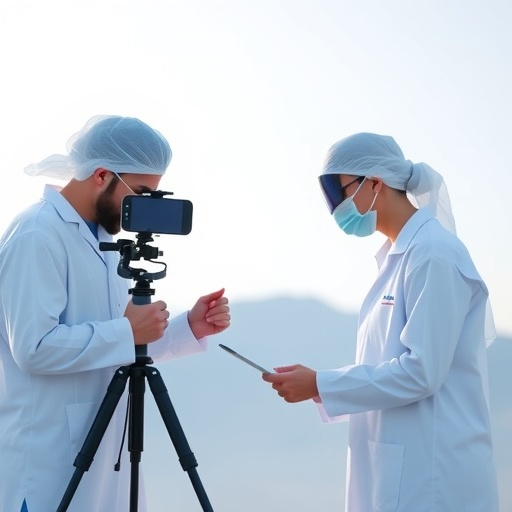Title: Revolutionizing Medical Diagnostics: The Emergence of Portable Field Endoscopy
In the rapidly evolving landscape of medical technology, one innovation stands out as particularly transformative: portable field endoscopy. This preliminary research, articulated by a team of pioneering scientists, tackles the pressing challenges, hidden opportunities, and the future implications of deploying portable endoscopic systems within military and civilian healthcare settings. The intricate dynamics of healthcare necessitate adaptable solutions that can function in diverse and frequently resource-limited environments, making this research particularly pertinent.
As healthcare systems are increasingly pushed to their limits, particularly in times of conflict, the necessity for efficient, accurate, and user-friendly diagnostic tools becomes paramount. Traditional endoscopic techniques, largely confined to hospital settings, can hinder timely patient evaluation and treatment in emergency scenarios. The portability of endoscopic devices redefines the parameters of accessibility and efficiency, offering the possibility of real-time diagnostics and interventions in the field.
The proposed portable endoscopy systems are designed to be lightweight and ergonomically sound, allowing for optimized maneuverability by medical personnel. This consideration is essential, as effective medical treatments often hinge on the speed of diagnosis. Such tools not only facilitate quicker responses in life-threatening environments but can also play a crucial role in preventive healthcare by identifying potential health crises before they escalate.
However, the shift towards portable technologies is not without challenges. One of the primary concerns revolves around the integration of advanced imaging technologies into compact devices. The ability to maintain high-resolution imaging without compromising portability remains a focal point of ongoing research. Innovations such as miniaturized optical systems and enhanced image processing algorithms are at the forefront of addressing this issue, promising to deliver clarity comparable to that achieved in conventional endoscopic procedures.
Additionally, the ergonomic design of portable endoscopes must accommodate a diverse range of users, including trained personnel in various environments from combat zones to remote rural clinics. This necessitates significant consideration of usability, including intuitive navigation and simplified maintenance. The ambition to democratize high-quality medical diagnostics is tied closely to ensuring that these tools can be effectively utilized by healthcare providers with varying levels of expertise.
Equally crucial is the aspect of data management. Portable endoscopic systems must feature integrated solutions for data collection, storage, and analysis. The advent of cloud storage and real-time data analytics opens avenues for leveraging big data to enhance diagnostic capabilities and patient outcomes. The ability to analyze patient data on-the-fly would not only streamline medical response but also contribute to a broader understanding of health trends in diverse populations.
Furthermore, the exploration of telemedicine within the realm of portable endoscopy presents unprecedented opportunities. Integrated connectivity features can enable remote specialists to assist during examinations, providing expert guidance in real-time. Such collaboration can ensure that patients receive the most accurate diagnoses and treatments, irrespective of geographical limitations or the experience level of on-site personnel.
The implications of this research extend beyond military settings; portable endoscopy could revolutionize rural and underserved regions where access to advanced medical technology is limited. The potential to deploy these systems in disaster relief scenarios or during public health crises such as pandemics exemplifies their value. Rapid testing and identification of pathogens could prove vital in managing outbreaks efficiently.
Training is, however, an essential component that accompanies the deployment of portable endoscopic technologies. Without effective training programs, even the most technologically advanced instruments could fall short of their potential. Comprehensive education and ongoing support for healthcare personnel are fundamental to harnessing the full capabilities of these devices in clinical practice.
The future of portable endoscopy remains bright yet complex, with ongoing research poised to address the multifaceted challenges ahead. As scientists and engineers collaborate, the goal of producing highly effective, portable diagnostic systems is steadily advancing. The integration of artificial intelligence, machine learning, and automated imaging could streamline endoscopic procedures and enhance diagnostic accuracy even further.
Additionally, regulatory pathways for these technologies must evolve in tandem with their development. Establishing clear guidelines and standards will ensure that these portable endoscopy systems not only function effectively but also adhere to the highest safety and efficacy standards. The role of healthcare policymakers in fostering an environment conducive to innovation is critical in this context.
In conclusion, the journey towards establishing portable field endoscopy as a standard component of medical diagnostics is filled with potential yet riddled with challenges. As researchers continue to navigate this complex terrain, the prospects for improving patient care across various settings remain exceptionally promising. The culmination of these efforts could usher in a new era of medical diagnostics, characterized by increased accessibility, improved outcomes, and ultimately, enhanced quality of life for patients worldwide.
Through the ongoing exploration of portable endoscopy, we inch closer to a reality where high-quality healthcare can be delivered promptly, regardless of the patient’s location. The commitment to overcoming existing challenges and embrace forthcoming opportunities is what will truly define the success of this technological innovation in the years to come.
Subject of Research: Portable Field Endoscopy
Article Title: Challenges, opportunities, and future perspectives of portable field endoscopy
Article References:
He, K., Wang, SY. & Ren, J. Challenges, opportunities, and future perspectives of portable field endoscopy.
Military Med Res 12, 80 (2025). https://doi.org/10.1186/s40779-025-00666-4
Image Credits: AI Generated
DOI: https://doi.org/10.1186/s40779-025-00666-4
Keywords: Portable Endoscopy, Medical Technology, Diagnostics, Telemedicine, Data Management, Healthcare Innovations, Military Medicine, Rural Healthcare.
Tags: challenges in medical diagnosticscivilian healthcare innovationsemergency medical interventionsergonomic design in medical devicesfuture of endoscopy technologylightweight endoscopic devicesmilitary medical applicationsopportunities in portable healthcareportable field endoscopypreventive healthcare technologiesreal-time diagnostic toolsresource-limited healthcare solutions





